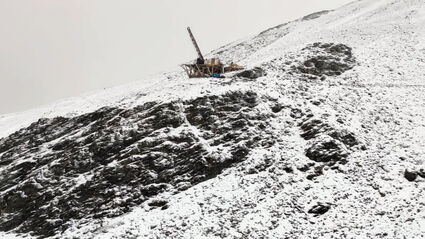Snow ends 2020 Last Chance gold drilling
White Rock completes 8 holes at Red Mountain gold discovery North of 60 Mining News – September 18, 2020
Last updated 9/26/2020 at 3:28pm

White Rock Minerals Ltd.
Snow blankets the mountainside as crews drill the final hole of the 2020 season at the Last Chance gold discovery on White Rock Minerals' Red Mountain project in Alaska.
White Rock Minerals Ltd. Sept. 15 reported that it tested the Last Chance gold discovery with 1,990 meters of drilling in eight holes before a blanket of snow marked the end of the 2020 exploration season at its Red Mountain project in Alaska.
"Considering the Last Chance gold target started as a stream sediment anomaly earlier this year, our 2020 field season accomplished a lot," said Quinton Hennigh, a technical advisor to White Rock Minerals.
Best known for its zinc-rich volcanogenic massive sulfide (VMS) deposits and occurrences, this 308-square-mile (798 square kilometers) Red Mountain property lies within the Tintina Gold Belt, a particularly gold-rich province that sweeps across Canada's Yukon Territory and Alaska.
A detailed regional stream sediment program completed in 2019 led to the discovery of Last Chance, a gold prospect at the west end of the district-scale Red Mountain property.
To better understand the gold mineralization at Last Chance and refine targets for a drill program that got underway in August, a team of six geologists completed reconnaissance and systematic soil sampling across the target.
"Our crews managed to collect sufficient soil sample data to define an enormous gold-arsenic system over a six-kilometer (3.7 miles) strike and 1.2-kilometer (0.75 miles) width," said Hennigh. "Geological reconnaissance identified multiple high-level hydrothermal silica breccia bodies distributed throughout the target area in spite of the fact that steep talus slopes conceal up to 95% of the underlying geology."
This sampling outlined a 3,550- by 500-meter core within the larger Last Chance target.
The first target of the 2020 Last Chance drill program was Pickle, a target where soil sampling returned assays as high as 2.11 g/t and 1.05 g/t gold.
Three holes were drilled at Pickle. White Rock has received partial assays from the first two holes, LC20-01 and LC20-02. LC20-01 cut 15.7 meters averaging 0.1 g/t gold, and LC20-02 cut 18.2 meter of 0.1 g/t gold.
A deep hole had been planned for Pickle but was not completed due to the onset of winter. White Rock said Pickle is a high-priority target for the 2021 drill season.
Two of the holes drilled this year targeted Sidewinder West, a target at the western end of the Last Chance core where sampling returned assays up to 2.2 g/t and 7.1 g/t gold. White Rock completed two holes at Sidewinder West, assays are pending.
One rock chip sample collected from a narrow quartz vein southwest of Sidewinder West, an area known as Sidewinder Blowout, contained 77.3 g/t gold. Two holes were drilled at SW Blowout, assays are pending.
One hole was also drilled at Double Down, a prospect about 500 meters south of Sidewinder West, where sampling returned 2.77 g/t and 1.16 g/t gold. Assays are pending from this hole.
Towards the end of the 2020 field season, four lines of a controlled-source audiomagnetotellurics (CSAMT) geophysical survey were completed across the core of the Last Chance gold target to determine the effectiveness of the technique in mapping resistivity contrasts that could be associated with the mineralizing system and thus provide data to refine drill targeting, especially to identify prospective deeper structural zones.

White Rock Minerals Ltd.
Looking east toward the Sidewinder trend at Last Chance as a drill completes hole LC20-05 at the Double Down gold target.
Interpretation of the CSAMT data, in conjunction with integrating the other geophysical, sampling, and drilling information collected this year, will be used to increase the understanding of the mineralizing system in preparation for planning the 2021 drill season.
"We eagerly await assays from most holes. In the meantime, we will commence integrating geological, geochemical, magnetics and first pass CSAMT data to further interpret the system and plan for our 2021 drill season," said Hennigh. "We tested only a very small part of this extensive system. There still remains multiple undrilled targets at surface, and we strongly believe that the extensive bodies of silica breccia discovered to date indicate a lot more is happening at depth. This deeper regime will likely be the focus of much of our exploration effort next season."















Reader Comments(0)